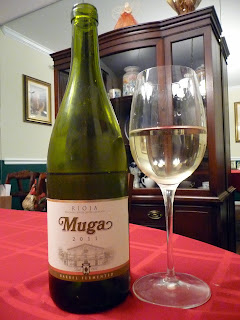When one thinks of Rioja wine, thoughts usually turn to red wine, tinto. The reason may lie with the fact that 85% of the grapes cultivated in the La Rioja, the denominación de origen calificada, are red grapes (Tempranillo primarily, but also Garnacha Tinta, Graciano, and Mazuelo). This obviously leads to an abundance of Rioja tinto wines.
Yet, winemakers in La Rioja also make other wines, such as a blanco, which is made with the Viura grape, also known as Macabeo. This grape is grown throughout La Rioja, as well as in Catalunya and Languedoc-Roussillon. The Viura or Macabeo grape produces young, acidic wines. However, winemakers often use the grape in blends, such as blending it with Xarel-lo and Parellada grapes to produce Cava. The Viura grape can also be blended with some Malvasia and/or Garnacha Blanco grapes to produce the Rioja Blanco.
For the longest time, I have been wanting to buy and try a Rioja Blanco made by Muga. I previously tried a Rioja Rose (or rosado) when I was pairing Spanish wines for a four course Spanish meal. The rose wine was very good and, during my research, I only read good things about Muga wines. So, I recently bought a bottle of Rioja Blanco to serve with a dinner that I made for my parents.
Yet, winemakers in La Rioja also make other wines, such as a blanco, which is made with the Viura grape, also known as Macabeo. This grape is grown throughout La Rioja, as well as in Catalunya and Languedoc-Roussillon. The Viura or Macabeo grape produces young, acidic wines. However, winemakers often use the grape in blends, such as blending it with Xarel-lo and Parellada grapes to produce Cava. The Viura grape can also be blended with some Malvasia and/or Garnacha Blanco grapes to produce the Rioja Blanco.
For the longest time, I have been wanting to buy and try a Rioja Blanco made by Muga. I previously tried a Rioja Rose (or rosado) when I was pairing Spanish wines for a four course Spanish meal. The rose wine was very good and, during my research, I only read good things about Muga wines. So, I recently bought a bottle of Rioja Blanco to serve with a dinner that I made for my parents.
Muga produces its Rioja Blanco with a blend of 90% Viura (Macabeo) and 10% Malvasia grapes. The grapes are picked from vines that grow in clay and alluvial soils. The winemaker's process results in half of the picked grapes being excluded from the wine process. The wine is barrel fermented for three months on its lees (yeast), and then bottled.
The Rioja Blanca wine is a very pale yellow in color. Given its youth, the wine is very aromatic, with scents of apples and a little pear or peach. The winemaker describes this wine as having aromas of pineapple and peaches in syrup or honey. Other reviewers described aromatic elements such as vanilla, almond, wild herbs and "buttery brioche." Perhaps my olfactory senses are not well developed, but I could see the peaches and had a more difficult time sensing the other aromas. As for the palette, the wine definitely had the taste of ripe apples, along with some pear and perhaps a little herb de provence in the background. Those other reviewers found pineapple and guava, and perhaps a little spice from the barrel aging. I could sense the fact that this wine was barrel aged, because it was a little smoother than I would have expected for a wine that is described as young and ready to be consumed now.
As I mentioned above, I bought this wine to pair with a meal that I made for my parents. The meal began with Ensalada Murciana con Queso Murcia al Vino or Drunken Goat Cheese and Tomato Salad. The wine went very well with the tomatoes and cheese. The main course was Cordero Asado con Patatos, or Roast Rack of Lamb with Potatoes. The Rioja Blanco actually went very well with the roast lamb and complemented the herbs used with the potatoes.
I found this wine at a local grocery store where it sells for $16.99 a bottle.
ENJOY!


No comments:
Post a Comment